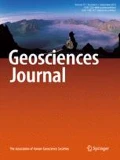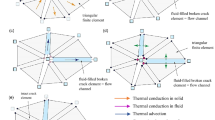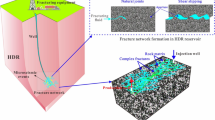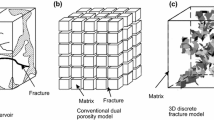Abstract
Natural fractures have a significant effect on fluid flow and heat transfer in naturally fractured geothermal reservoirs. However, most previous studies have assumed that reservoir systems are either a single continuum or dual continuum model, while some studies have just considered a pipeline model. In this study, we developed a discrete fracture network (DFN) geothermal reservoir simulator. The DFN model developed was validated for synthetic fracture systems using a Tetrad; a comparison of the results revealed good agreement between two models. However, developed model is only a fracture model and cannot simulate fluid flow and heat transfer in the matrix. A matrix flow model will be added in the future.
Similar content being viewed by others
References
Bratton, T., 2006, The nature of naturally fractured reservoirs. Oilfield Review, 18, 4–23.
Cacas, M.C., Ledoux, E., de Marsily, G., Tillie, B., Barbreau, A., Durand, E., Feuga, B., and Peaudecerf, P., 1990, Modeling fracture flow with a stochastic discrete fracture network: calibration and validation: 1. the flow model. Water Resources Research, 26, 479–489.
Cheng, L., Rong, G., and Yang, J., 2017, Fluid flow through single fractures with directional shear dislocations. Transport in Porous Media, 118, 1–26.
Cottereau, N., Garcia, M.H., Gosselin, O.R., and Vigier, L., 2010, Effective fracture network permeability: comparative study of calculation methods. Society of Petroleum Engineers 131126, SPE EUROPEC/EAGE, Barcelona, Jun. 14–17, p. 1–31.
Graf, T. and Therrien, R., 2008, A method to discretize non-planar fractures for 3D subsurface flow and transport simulations. International Journal for Numerical Methods in Fluids, 56, 2069–2090.
Granet, S., Fabrie, P., Lemonnie, P., and Quintard, M., 1998, A singlephase flow simulation of fractured reservoir using a discrete representation of fractures. 6th European Conference on the Mathematics of Oil Recovery, Peebles, Sep. 8–11, p. 1–7.
Holm, R., Kaufmann, R., Heimsund, B., Fian, E., and Espadal, M.S., 2006, Meshing of domains with complex internal geometries. Numerical Linear Algebra with Applications, 13, 717–731.
Jahediesfanjani, H. and Civan, F., 2006, Improving performance of the naturally fractured carbonate reservoirs by means of various stimulation and completion techniques. Society of Petroleum Engineers 103986, The International Oil Conference and Exhibition, Cancun, Aug. 31–Sep. 2, p. 1–12.
Jambayev, A.S., 2007, Discrete fracture network modeling for a carbonate reservoir. Master Thesis, Colorado School of Mines, Golden, 87 p.
Karimi-Fard, M., Durlofsky, L.J., and Aziz, K., 2003, An efficient discrete fracture model applicable for general purpose reservoir simulators. Society of Petroleum Engineers 79699, SPE Reservoir Simulation Symposium, Houston, Feb. 3–5, p. 227–236.
Kishida, K., Sawada, A., Yasuhara, H., and Hosoda, T., 2013, Estimation of fracture flow considering the inhomogeneous structure of single rock fractures. Soil and Foundations, 53, 105–116.
Klimczak, C., 2010, Cubic law with aperture-length correlation: implications for network scale fluid flow. Hydrogeology Journal, 18, 851–862.
Lee, W.S., 2010, Numerical simulation techniques in heavy oil carbonate reservoirs. Geosystem Engineering, 13, 69–76.
Li, W., Yost, K., and Sousa, R., 2013, Heat transfer between fluid flow and fractured rocks. GRC Transactions, 37, 165–171.
Nordahl, K. and Ringrose, P.S., 2008, Identifying the representative elementary volume for permeability in heterolithic deposits using numerical rock models. Math Geoscience, 40, 753–771.
Ogbechie, J.N., 2011, Fracture modeling and flow behavior in shale gas reservoirs using discrete fracture networks. Master Thesis, Texas A&M University, College Station, 152 p.
Oron, A.P. and Berkowitz, B., 1998, Flow in rock fractures: The local cubic law assumption reexamined. Water Resources Research, 34, 2811–2825.
Pruess, K., 1981, Heat transfer in fractured geothermal reservoirs with boiling. 7th Workshop on Geothermal Reservoir Engineering, San Francisco, Dec. 15–17, p. 151–156.
Rogers, SF., Elmo, D., and Dershowitz, W.S., 2011, Understanding hydraulic fracture geometry and interaction in preconditioning through DFN and numerical modeling. 45th US Rock Mechanics/Geomechanics Symposium, San Francisco, Jun. 26–29, p. 1–6.
Romm, E.S., 1966, Fluid flow in fractured rocks. Nedra Publishing House, Moscow, 283 p. (in Russian)
Sanyal, S.K., Butler, S.J., Swenson, D., and Hardeman, B., 2010, Review of the state-of-the-art of numerical simulations of enhanced geothermal systems. World Geothermal Congress, Kyushu-Tohoku, May 28–Jun. 10, p. 3853–3858.
Sarkar, S., Toksoz, M.N., and Burn, D.R., 2004, Fluid flow modelling in fractures. Consortium Report MIT Earth Resources Laboratory Industry Consortium Meeting, MIT, Cambridge, 41 p.
Shiriyev, J., 2014, Discrete fracture network modeling in a carbon dioxide flooded heavy oil reservoir. Master Thesis, Middle East Technical University, Ankara, 67 p.
Tamagawa, T., Tezuka, K., and Namikawa, T., 2002, Fracture network modeling using electrical borehole images. 43rd Annual Logging Symposium, Oiso, Jun. 2–5, p. 1–10.
Warren, J.E. and Root, P.J., 1963, The behavior of naturally fractured reservoirs. Society of Petroleum Engineers Journal, 3, 245–254.
Watanabe, K. and Takahashi, H., 1995, Fractal geometry characterization of geothermal reservoir fracture networks. Journal of Geophysical Research, 100, 521–528.
Witherspoon, P.A., Wang, J.S.Y., Iwai, K., and Gale, J.E., 1980, Validity of cubic law for fluid flow in a deformable rock fracture. Water Resources Research, 16, 1016–1024.
Wu, Y.S. and Pruess, K., 2005, A physically based numerical approach for modeling fracture-matrix interaction in fractured reservoirs. World Geothermal Congress, Antalya, Apr. 24–29, p. 1–8.
Author information
Authors and Affiliations
Corresponding author
Rights and permissions
About this article
Cite this article
Lee, T., Kim, K., Lee, K. et al. Development of fluid flow and heat transfer model in naturally fractured geothermal reservoir with discrete fracture network method. Geosci J 22, 477–485 (2018). https://doi.org/10.1007/s12303-017-0035-3
Received:
Accepted:
Published:
Issue Date:
DOI: https://doi.org/10.1007/s12303-017-0035-3




